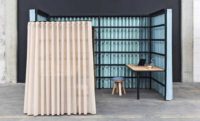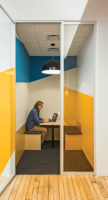Patient privacy, comfort, and well-being are paramount in healthcare facilities. Increasingly, noise management is an important piece of the equation. Architecture and design firms are rising to the occasion, incorporating acoustic elements in unexpected ways to create the calmest atmosphere possible for guests and staff alike.
University of Arizona Cancer Center, Phoenix
Portland, Oregon–based ZGF Architects used machinery and acoustic products to aggressively block noise at the 220,000- square-foot healthcare institute, which is part of St. Joseph’s Hospital and Medical Center. Aside from using a sustainable HVAC system that decouples ventilation from heating and cooling, ZGF incorporated Price Industries’ chilled beams. Each delivers air at lower velocities and eliminates drafts: an important consideration for infusion therapy patients spending long stretches of time in treatment. Though an inherently quiet system, the beams are purposely louder in select spaces, including waiting and circulation areas, to mask confidential conversations.
The team incorporated Modernfold demountable partitions, Flavor Paper and Forbo wallcoverings, and Forbo, Acrovyn, and Sequentia Structoglas paneling near treatment rooms to lessen vocal and equipment reverberation. High-performance acoustic ceiling tiles from USG and Decoustics in corridors and staff work areas absorb sound. Plus the walls enclosing the exam, treatment, and consultation rooms achieve a privacy-protecting Sound Transmission Class (STC) rating of 50 thanks to a unique solution. “We supplemented one side of a typical metal-stud and gypsum-board wall with an additional layer of gypsum board and fiberglass acoustic insulation in the stud cavity,” says ZGF principal Brett Meyer, adding that this is not typically done in clinical situations.
1525, Washington, D.C.
Throughout this LEED-CI Gold health center specializing in HIV treatment and care are acoustic panels and wallcoverings that reduce noise. International design firm Perkins+Will used Kirei’s Echopanel ceiling blades over the pharmacy counter area to muffle patient discussions with staff. Custom backlit resin panels fabricated by 3form sit between stations, blocking sound and serving as privacy screens. “The baffles and panels offered a cost-effective, cleanable, and environmentally conscious solution” to soundproofing these areas, explains David Cordell, the project’s lead designer.
In the client services area, more Kirei ceiling panels—from the Mura line—reduce noise. Their bright colors and distinctive forms also serve as wayfinding elements, demarcating reception areas. Walls between exam rooms are fully lined with acoustic fiberglass batt insulation. “We even staggered outlets and other wall device locations between rooms to prevent sound transmission,” adds Cordell.
The facility’s dental operatory rooms, however, proved the greatest challenge. Located in the windowless lower level of the 42,000-square-foot building, the large, open suites maximize light—and amplify noise. The team opted for Armstrong Ceilings’ Optima high-NRC mineral-fiberglass tiles to absorb and block sound. They coupled those with Hytex’s Virga Eco-A.R.T wallcoverings—made of 100 percent recycled material imbued with antimicrobial properties—to lend additional style and acoustic support.
Duke Cancer Center, Durham, North Carolina
A self-contained space within Duke’s Comprehensive Cancer Center, the Quiet Room, designed by local firm Duda|Paine Architects, uses an integrated system of light and sound to produce a meditative place for up to 12 patients and their families.
Created in conjunction with United Engineering Group and Cline Bettridge Bernstein Lighting Design, the circular room—measuring 30 feet across—features a Creston controller and DMX acoustic and light system that allows users to choose from over a dozen calming musical scores. Coordinating illumination mimics the changing light over the day and seasons, while fabric-wrapped 3form acoustic panels and benches upholstered in Knoll Textiles help muffle outside distractions.
To increase the contemplative nature of the space, Duda|Paine enlisted the Tallahassee, Florida–based Kaiser/von Roenn Studio Group to create a waterless fountain centerpiece. (For code reasons, an actual fountain was not possible.) Paired with carefully programmed LEDs and noise effects, the 60-inch-diameter sculpture offers the illusion of moving water, “engaging the space’s occupants visually and acoustically,” explains Turan Duda, cofounder of Duda|Paine.
The Quiet Room was designed to enhance the mental health of hospital patients, staff, and visitors via sound curation: an approach far different from abatement. Designers know excessive noise in a healthcare environment can adversely affect patient and staff comfort and communication, so its use and control is the next frontier










